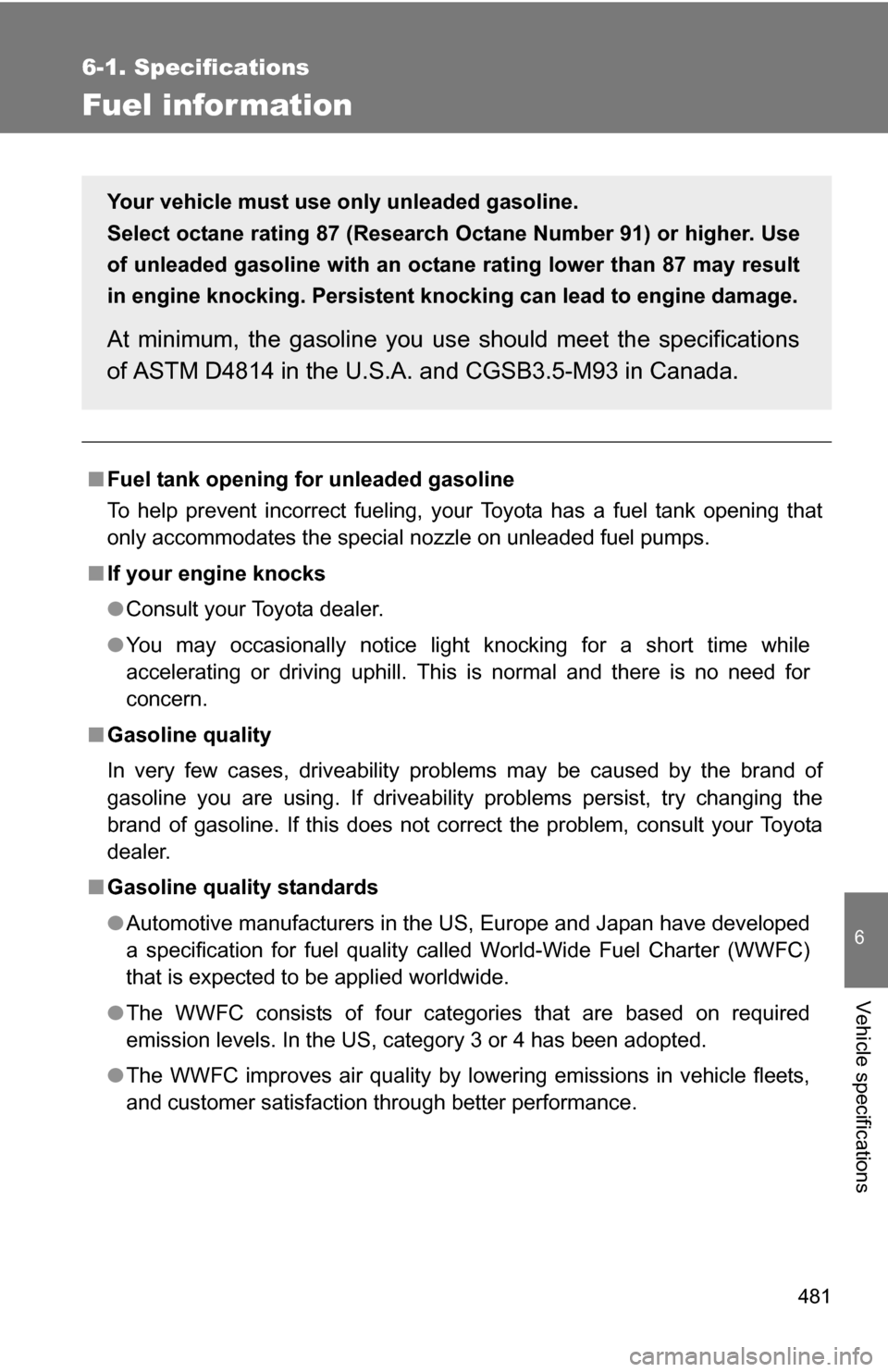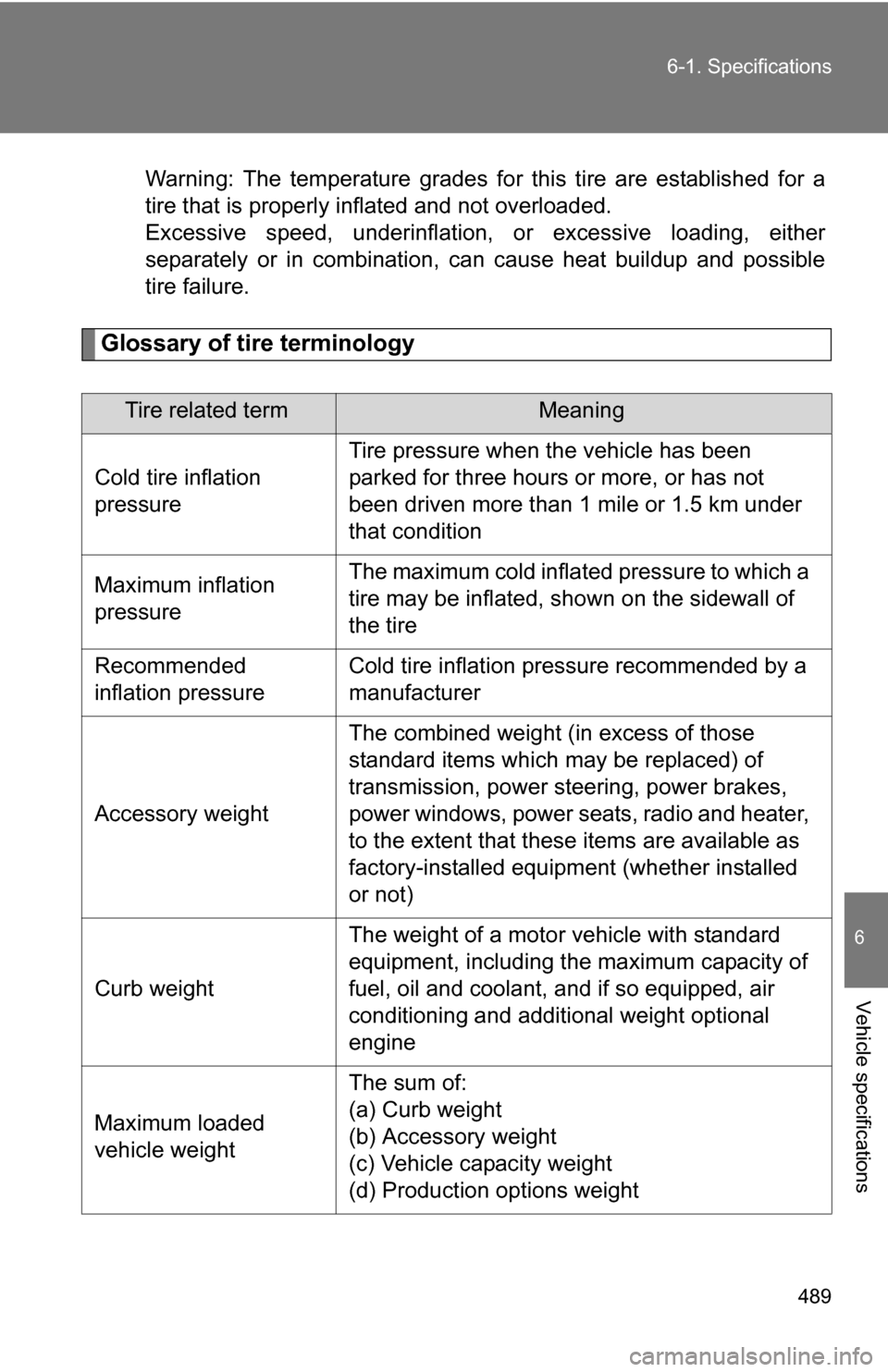Page 477 of 520
477
6-1. Specifications
6
Vehicle specifications
Automatic transmission
*: The fluid capacity is the quantity of reference. If replacement is necessary,
contact your Toyota dealer.
Transfer (4WD models)
Fluid capacity *
4.0 L V6 (1GR-FE) engine
10.9 qt. (10.4 L, 9.1 Imp.qt.)
4.7 L V8 (2UZ-FE) engine
10.9 qt. (10.4 L, 9.1 Imp.qt.)
Fluid type Toyota Genuine ATF WS
NOTICE
■Automatic transmission fluid type
Using automatic transmission fluid other than “Toyota Genuine ATF WS”
may cause deterioration in shift quality, locking up of your transmission
accompanied by vibration, and ultimately damage the automatic
transmission of your vehicle.
Oil capacity 1.5 qt. (1.4 L, 1.2 Imp.qt.)
Oil type Hypoid gear oil API GL-5
Recommended oil viscosity SAE 75W-90
Page 478 of 520
478 6-1. Specifications
Brakes
*1: Minimum pedal clearance when depressed with a force of 110 lbf (490 N,50 kgf) with the engine running.
*2: Parking brake pedal travel when depressed with a force of 66.1 lbf (294 N,30 kgf).
Chassis lubrication
Steering
Pedal clearance *12.1 in. (54 mm) Min.
Pedal free play 0.04 0.24 in. (1 6 mm)
Brake pad wear limit 0.04 in. (1.0 mm)
Parking brake lining wear
limit 0.04 in. (1.0 mm)
Parking brake pedal travel *25 — 7 clicks
Fluid type
FMVSS No. 116 DOT 3 or SAE J1703
Propeller shafts Spider
Slide yokeLithium base chassis grease, NLGI No.2
Molybdenum — disulfide lithium base
chassis grease, NLGI No.2 or lithium base
multipurpose grease, NLGI No.2
Free playLess than 1.2 in. (30 mm)
Power steering fluid type
Automatic transmission fluid DEXRON® II or
III
Page 481 of 520

481
6-1. Specifications
6
Vehicle specifications
Fuel infor mation
■Fuel tank opening fo r unleaded gasoline
To help prevent incorrect fueling, your Toyota has a fuel tank opening that
only accommodates the special nozzle on unleaded fuel pumps.
■ If your engine knocks
●Consult your Toyota dealer.
● You may occasionally notice light knocking for a short time while
accelerating or driving uphill. This is normal and there is no need for
concern.
■ Gasoline quality
In very few cases, driveability problems may be caused by the brand of
gasoline you are using. If driveability problems persist, try changing the
brand of gasoline. If this does not correct the problem, consult your Toyota
dealer.
■ Gasoline quality standards
●Automotive manufacturers in the US, Europe and Japan have developed
a specification for fuel quality called World-Wide Fuel Charter (WWFC)
that is expected to be applied worldwide.
● The WWFC consists of four categories that are based on required
emission levels. In the US, category 3 or 4 has been adopted.
● The WWFC improves air quality by lowering emissions in vehicle fleets,
and customer satisfaction through better performance.
Your vehicle must use only unleaded gasoline.
Select octane rating 87 (Research Octane Number 91) or higher. Use
of unleaded gasoline with an octane rating lower than 87 may result
in engine knocking. Persistent kno cking can lead to engine damage.
At minimum, the gasoline you use should meet the specifications
of ASTM D4814 in the U.S.A. and CGSB3.5-M93 in Canada.
Page 482 of 520

482 6-1. Specifications
■Toyota recommends the use of gaso line containing detergent additives
● Toyota recommends the use of gasoline that contains detergent additives
to avoid build-up of engine deposits.
● All gasoline sold in the US contains detergent additives to clean and/or
keep clean intake systems.
■ Toyota recommends the use of cleaner burning gasoline
Cleaner burning gasoline, including reformulated gasoline that contains
oxygenates such as ethanol or MTBE (Methyl Tertiary Butyl Ether) is
available in many areas.
Toyota recommends the use of cleaner burning gasoline and appropriately
blended reformulated gasoline. These types of gasoline provide excellent
vehicle performance, reduce vehicle emissions and improve air quality.
■ Toyota does not recomm end blended gasoline
● Toyota allows the use of oxygenate blended gasoline where the
oxygenate content is up to 10% ethanol or 15% MTBE.
● If you use gasohol in your Toyota, be sure that it has an octane rating no
lower than 87.
● Toyota does not recommend the use of gasoline containing methanol.
■ Toyota does not recommen d gasoline containing MMT
Some gasoline contains octane enhancing additive called MMT
(Methylcyclopentadienyl Manganese Tricarbonyl).
Toyota does not recommend the use of gasoline that contains MMT. If fuel
containing MMT is used, your emission control system may be adversely
affected.
The malfunction indicator lamp on the instrument cluster may come on. If
this happens, contact your Toyota dealer for service.
Page 483 of 520
483
6-1. Specifications
6
Vehicle specifications
NOTICE
■
Notice on fuel quality
●Do not use improper fuels. If improper fuels are used the engine will be
damaged.
● Do not use leaded gasoline.
Leaded gasoline can cause damage to your vehicle’s three-way catalytic
converters causing the emission control system to malfunction.
● Do not use gasohol other than that stated here.
Other gasohol may cause fuel system damage or vehicle performance
problems.
● Use of unleaded gasoline with an octane rating lower than 87 may result in
engine knocking. Persistent knocking can lead to engine damage and
should be corrected by refueling with higher octane unleaded gasoline.
■ Fuel-related poor driveability
If after using a different type of fuel, poor driveability is encountered (poor
hot starting, vaporization, engine knocking, etc.), discontinue the use of that
type of fuel.
■ When refueling with gasohol
Take care not to spill gasohol.
It can damage your vehicle’s paint.
Page 489 of 520

489
6-1. Specifications
6
Vehicle specifications
Warning: The temperature grades for this tire are established for a
tire that is properly inflated and not overloaded.
Excessive speed, underinflation,
or excessive loading, either
separately or in combination, can cause heat buildup and possible
tire failure.
Glossary of tire terminology
Tire related termMeaning
Cold tire inflation
pressure
Tire pressure when the vehicle has been
parked for three hours or more, or has not
been driven more than 1 mile or 1.5 km under
that condition
Maximum inflation
pressureThe maximum cold inflated pressure to which a
tire may be inflated, s hown on the sidewall of
the tire
Recommended
inflation pressureCold tire inflation pressure recommended by a
manufacturer
Accessory weight
The combined weight (in excess of those
standard items which may be replaced) of
transmission, power steering, power brakes,
power windows, power seats, radio and heater,
to the extent that these items are available as
factory-installed equipment (whether installed
or not)
Curb weight
The weight of a motor vehicle with standard
equipment, including the maximum capacity of
fuel, oil and coolant, and if so equipped, air
conditioning and additional weight optional
engine
Maximum loaded
vehicle weight
The sum of:
(a) Curb weight
(b) Accessory weight
(c) Vehicle capacity weight
(d) Production options weight
Page 497 of 520
497
6-2. Customization
6
Vehicle specifications
Illumination
(
P. 305)
Time elapsed before
lights turn off
15 seconds7.5 seconds
30 seconds
Operation after the
engine switch is turned
to the LOCK position ON OFF
Operation when the
doors are unlocked ON OFF
Seat Belt
Reminder
Buzzer
(
P. 439) Vehicle speed linked
seat belt reminder
buzzer
ON OFF
ItemFunctionDefault settingCustomized
setting
Page 498 of 520
498
6-2. Customization
Items to initialize
ItemWhen to initializeReference
Power windows
• After reconnecting or changing the battery
• After changing a fuse
P. 7 6
Power back windowP. 7 9
Back doorP. 3 8
Moon roofP. 8 2
Engine oil maintenance
dataAfter changing engine oilP. 378
The following items must be initia lized for normal system operation
in cases such as after the battery is reconnected, or maintenance is
performed on the vehicle.